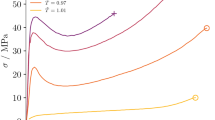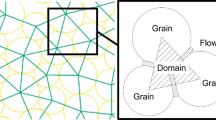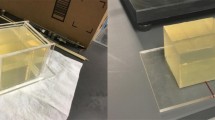Abstract
Description of a disc-shaped geothermal reservoir, pressurized and subject to thermal stresses, is given in terms of notions employed in mechanics of ductile fracture. The reservoir is assumed to extend in an infinite isotropic and impermeable medium. Range of the analysis, however, is extended to include a possibility of quasi-static stable cracking occurring along the reservoir circumference prior to spontaneous fracture. Extensive microcracking occuring in the region adjacent to the crack front prior to the onset of crack growth (and in the presence of high tectonic pressure encountered in a geothermal system) provides a stabilizing effect, similar in its nature to ductility exhibited in metal fracture.
Numerical example given here shows that the theoretical estimate of the upper critical flow rate of the fluid pumped through the reservoir, at which fracture becomes spontaneous, can be considerably increased (as compared with the values obtained within the LEFM framework) when the nonlinear inelastic behavior of rocks containing the reservoir is accounted for. Available data indicate that the rate of crack extension during the early stage of crack growth can be reduced by several orders of magnitude depending on physical and geometrical factors controlling the microcracking, process. Such result implies widening of the safety margin for a hot dry rock geothermal system.
The results given here may also be of use in designing the hydraulic fracturing experiments and in testing various fracturing concepts.
Résumé
On décrit un réservoir géothermique en forme de disque pressurisé et soumis à des contraintes thermiques en termes de notions utilisées en mécanique de rupture ductile. Le réservoir est supposé se trouver dans un milieu infini isotrope et imperméable. L'étendue de l'analyse toutefois est telle qu'elle inclut la possibilité d'une fissuration quasi statique et stable se produisant le long de la circonférence du réservoir avant la rupture spontanée. Un microfissuration intense se produisant dans la région adjacente au front de la fissure avant le démarrage de la croissance de la fissure et en présence des pressions tectoniques élevées rencontrées dans le système géothermique possède un effet stabilisant similaire par sa nature a la ductilité rencontrée dans la rupture des métaux.
L'exemple numérique fourni ici montre que l'estimation théorique du débit critique supérieur de fluide pompé au travers du réservoir auquel la rupture devient spontanée peut être considérablement accrue, quand on le compare aux valeurs obtenues dans le cadre de la mécanique de rupture linéaire élastique, lorsque l'on tient compte du comportement non linéaire inélastique de la roche comportant le réservoir. Les données disponibles indiquent que la vitesse de l'extension de la fissure au cours du stade primaire de la propagation de fissure peut être réduite de plusieurs ordres de grandeur suivant les facteurs physiques et géométriques contrôlant le processus de micro-fissuration. Un tel résultat implique un élargissement de la marge de sécurité dans le cas d'un système géothermique comportant des roches chaudes ou sèches.
Les résultats fournis peuvent également être appliqués dans la conception d'essai de rupture sous condition hydraulique et dans la mise à l'épreuve de divers concepts de rupture.
Similar content being viewed by others
References
H.Sekine and T.Mura, Characterization of Penny-shaped Reservoir in Hot Dry Rock, Progress Report, LASL, Northwestern University, Evanston, IL (1979).
P.W.Bridgman, Journal of Applied Physics, 18 (1947) 248.
H.L.D.Pugh and E.F.Chandler in Progress of Mechanics of Deformable Media, Nauka, Moscow (1975) 430–470.
T. Marston, editor, EPRI Ductile Fracture Research Review Document, EPRI NP-70-SR (1978).
J.R.Rice, “The Mechanics of Quasi-static Crack growth”, TR No. 63, Division of Engineering, Brown University, Providence, RI (1978).
M.P.Wnuk in Proceedings of the International Conference on Dynamic Crack Propagation, Lehigh University, Noordhoff, The Netherlands (1972) 273–280.
M.P.Wnuk, Journal of Applied Mechanics, 41 (1974) 234–242.
Yu. P. Zheltov and S.A. Khristianovich, Izvestiya Akademii Nauk SSSR, OTN, No. 3 (1955) 3–41.
Yu. P. Zheltov, Izvestiya Akademii Nauk SSSR, No. 3 (1957) 180–182.
G.I.Barenblatt, Prikladraya MM 20 (1959) 434–444.
D.S.Dugdale, Journal of Mechanics and Physics of Solids, 8 (1960) 100.
B.A.Bilby, A.H.Cottrell and K.H.Swinden, Proceedings of the Royal Society of London, 272 Ser. A (1960) 304.
J.N.Goodier and F.A.Field in Fracture of Solids, Interscience, New York (1963) 103.
R.A. Schmidt and T.J. Lutz, “K IC and J IC of Westerly Granite-Effects of Thickness and In-plane Dimensions”, 11th National Symposium on Fracture Mechanics (1978) to be published.
R.G.Hoagland, G.T.Hahn and A.R.Rosenfield, Rock Mechanics, 5 (1973) 77–106.
L.M.Barker, “Theory for Determining K IC from Small, Non-LEFM Specimens”, TR 78–6R, TerraTek, Salt Lake City, Utah (1978).
T.K. Perkins and W.W. Krech, Transactions of Society of Petroleum Engineers 243 (1968).
T.K. Perkins and W.W. Krech, Society of Petroleum Engineers, Journal (1966) 308–314.
C.T.Forwood, Philosophical Magazine, 17, No. 148 (1968) 657–667.
M.P. Wnuk in ASTM Special Technical Publication 536 (1973) 64–75.
L.N.McCartney, International Journal of Fracture, 15, 1 (1979) 31–40.
B.Cotterell and J.K.Reddel, “The Essential Work of Plane Stress Ductile Fracture”, Technical Note S-4, Department of Mechanical Engineering, University of Sydney, Australia (May 1976).
M.P.Wnuk, International Journal of Fracture, 15, 6 (1979) 553–581.
J.R.Rice and E.P.Sorensen, Journal of Mechanics and Physics of Solids, 26 (1978) 163–186.
D.T.SecorJr. and D.D.Pollard, Geophysics Research Letters 2 (1975) 510.
H. Abe, T. Mura and L.M. Keer, Journal of Geophysical Research, 81, No. 29 5335; 85, No. 35, 6292.
Y.C.Hsu and F.Santosa, “The Stability of a Large Hydraulic Penny-Shaped Fracture (Crack) Near the Earth's Surface”, Rep. ME-89(78), LASL-494–1, Los Alamos Scientific Labs, NM (1978).
I.N.Sneddon, Proceedings of the Royal Society of London 187 (1946) 229.
W.W. Gerberich, “Fracture in Ceramics (Semi-Cohesive Model)”, Department of Chemical Engineering and Materials Science, University of Minnesota, to be published.
W.W.Gerberich, International Journal of Fracture, 13 (1977) RCR 535–538.
Z.Olesiak and M.P.Wnuk, International Journal of Fracture, 4 (1968) 383–396.
M.P.Wnuk, Transactions of ASME, Journal of Lubrication Technology, 90, Series F (1968) 56–65.
L.M. Keer and T. Mura in Proceedings of 1st International Conference of Fracture 1 (1965) 99–115.
S.Nemat-Nasser, L.M.Keer and K.S.Parihar, International Journal of Solids and Structures, 14 (1978) 409–430.
S. Nemat-Nasser, “Variational Methods for Analysis of Stability of Interacting Cracks”, Proceedings of IUTAM Symposium on Variational Methods in the Mechanics of Solids, Pergamon, to be published.
J.J. Weertman, private communication (1979).
Author information
Authors and Affiliations
Rights and permissions
About this article
Cite this article
Wnuk, M.P., Mura, T. Stability of a disc-shaped geothermal reservoir subjected to hydraulic and thermal loadings. Int J Fract 17, 493–517 (1981). https://doi.org/10.1007/BF00033344
Received:
Revised:
Issue Date:
DOI: https://doi.org/10.1007/BF00033344




